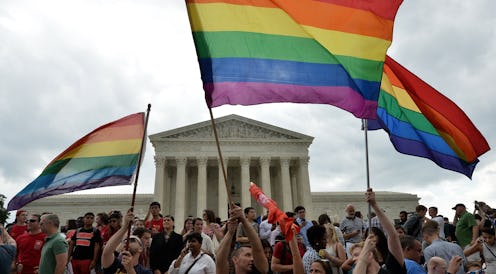Life
What Justice Roberts's Dissent Gets Very Wrong
The decisions are in and marriage equality is officially the law of the land! But while many of us are preparing to join in the nationwide party, not everyone is so excited — particularly not the Supreme Court justices who voted the other way in Obergefell v Hodges. But there are more than a few flaws in their reasoning.
In Chief Justice Roberts' dissenting opinion, which was also signed by Justices Scalia and Thomas, Roberts uses as one of his main objections the fact that marriage has always been defined as between a man and a woman "in every culture throughout human history." This statement is not only untrue, it is so blatantly untrue that it's a wonder a chief justice of the United States Supreme Court would ever say such a thing.
Chief Justice Roberts claims in his decision that he is not unsympathetic to the cause of marriage equality, he simply feels that it should be left up to the states to decide to redefine marriage, given that it is such a drastic shift. But in fact it is not as drastic as Roberts thinks. Contrary to popular belief, gay marriage was not invented in 2001 in the Netherlands.
The idea that marriage has always been a constant force that looked exactly the way it did in twentieth century America, in every society, every culture, and every time period is not only false, but ludicrous.
Although what marriage means and how it operates has obviously varied greatly across time and geography, there have been plenty of cultures in which marriage was certainly not limited "one man and one woman" Here are six cultures that prove Justice Roberts has marriage all wrong.
Ancient Rome
Although same-sex marriages seem to have been rare in Ancient Rome, during certain periods, wealthy and powerful men were able to marry their male partners, and at least two emperors, Nero and Elagabalus, married men in full ceremonies.
Medieval Spain
Surprisingly, the first recorded church wedding of a same-sex couple occurred not in the 21st century but the 11th. According to documents from a small chapel in Gallicia, two men, Pedro Díaz and Muño Vandilaz, were wed there on April 16, 1061. In addition, the rough equivalent of gay civil unions existed throughout Medieval Europe, despite the idea that they are a recent invention.
Ancient Hebrews
The idea that ancient Hebrews actually had marriages between people of the same sex is unlikely (though plenty of people interpret the Second Book of Samuel, 1:26 to mean King David at least wasn't opposed to same-sex relations), but they definitely had polygamy throughout much of the time period covered in the Old Testament. So that still pokes a big hole in Roberts's idea that "across [all] civilizations, 'marriage' referred to only one relationship: the union of a man and a woman." In fact, if that were true there would be no term for polygamy, which has been legally and socially sanctioned in many societies (including fairly recent ones here in America).
Pre-Columbian America
Throughout pre-Columbian North America, numerous indigenous cultures not only recognized LGBT people, but honored those identities. Today, Native activists use the term "two spirit" to refer to people who fall outside the Western idea of "traditional" sexuality and gender identity. Historically, however, there were at least 165 different Native American traditions between various tribes regarding what today we call LGBT people, many of which allowed for formal unions.
Pre-Colonial Central Africa
In traditional Central African cultures, there existed a tradition in which women married other women, typically in the case of widows who did not wish to remarry a man or return to their family. Marrying a woman typically did not not indicate a sexual relationship, but instead provided a way to preserve inheritance. However, the fact remains that it was a highly accepted practice, and a formally recognized, binding marriage.
Native Hawaiian Culture
In Hawaii, much like most of Polynesia, the idea of "marriage" as we understand it didn't really exist before contact with Europeans. People who wanted to live and raise children together simply did. If they wanted to stop, they stopped. Monogamy was not stressed, and there weren't many rules or taboos governing sexual relationships. In addition, Native Hawaiians were comfortable with people who didn't fit Western ideas of "normal" sexuality and gender identity.
Essentially, the idea that marriage has always been a constant force that looked exactly the way it did in twentieth century America, in every society, every culture, and every time period is not only false, but ludicrous. Some societies have allowed polygamy. Some societies did not have marriage in a formal sense at all. Some societies considered marriage to necessarily involve sexual relationships, some did not. The variety is as endless as the variety in human civilization and culture. And so, while I respect Chief Justice Roberts's desire not to overstep the purvey of the Court, to pretend that somehow same-sex marriage is something brand new, or that marriage itself has been a constant, is easily verified as false.
Images: Getty (6)
